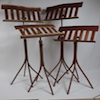Hello All,
First time to post and first time running my moulder. I have a couple of questions to hopefully obtain answers to. I purchased the W$H around five years ago for a song and never used it. Finally a job came up on my 1870's Queen Anne and I decided to give it a try. This unit is belt driven and is on a generic Kreg table with the moulder on top and the motor on the shelf below. I run it on 120 power. First question is as the unit lowers into the stock the belt slackens and the it loses head speed due to slippage. My solution was to move the motor laterally and do the last cuts on the retightened belt. Is there a more elegant method? I can think of using t-slots and sliding the motor as it slackens. I could also make a hinged base which travels through an arc lick a car alternator. Thoughts?
Also the automatic feeder rollers turn but during the first passes are at least 1/4" above the stock. From what I see there are pins which act as a hard stop so there is no way to lower the roller which I can see. So I end up hand feeding but even when it does engage it needs to be helped along. Bigger and newer rollers perhaps. Thanks in advance for your thoughts.




 Reply With Quote
Reply With Quote


